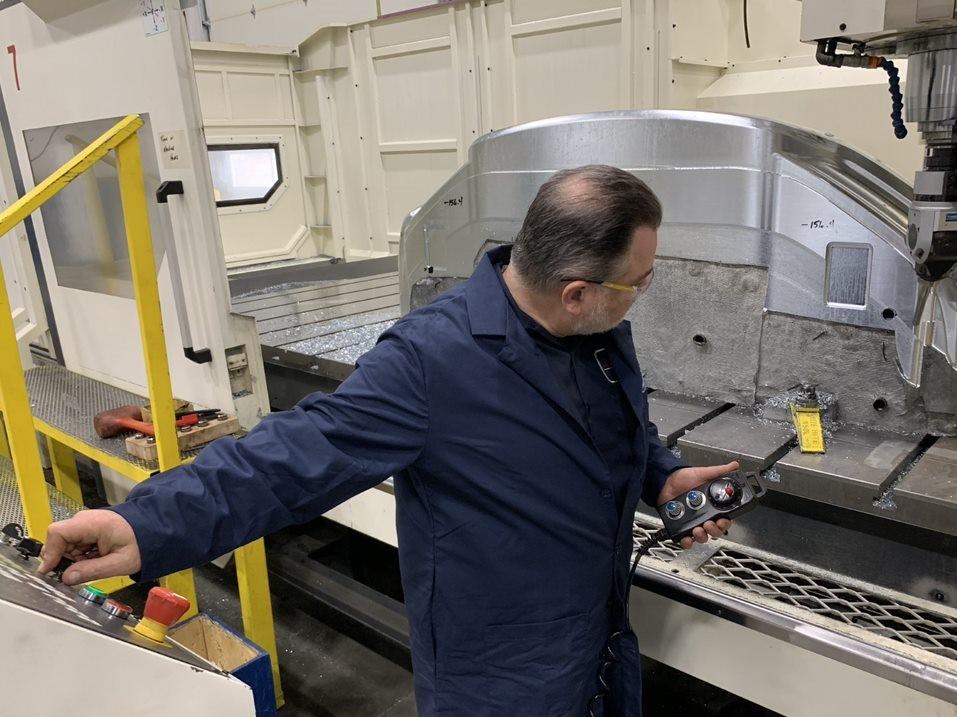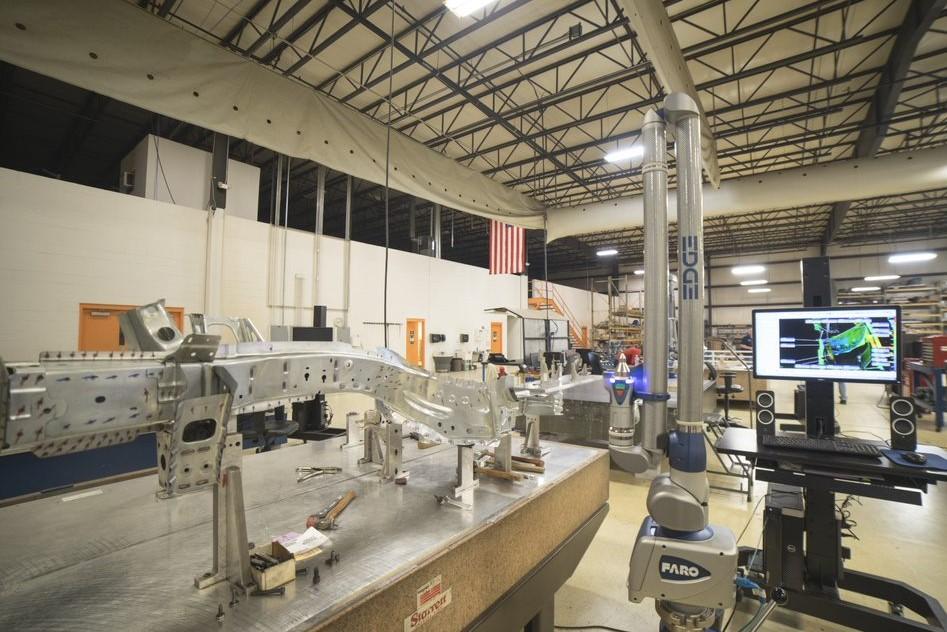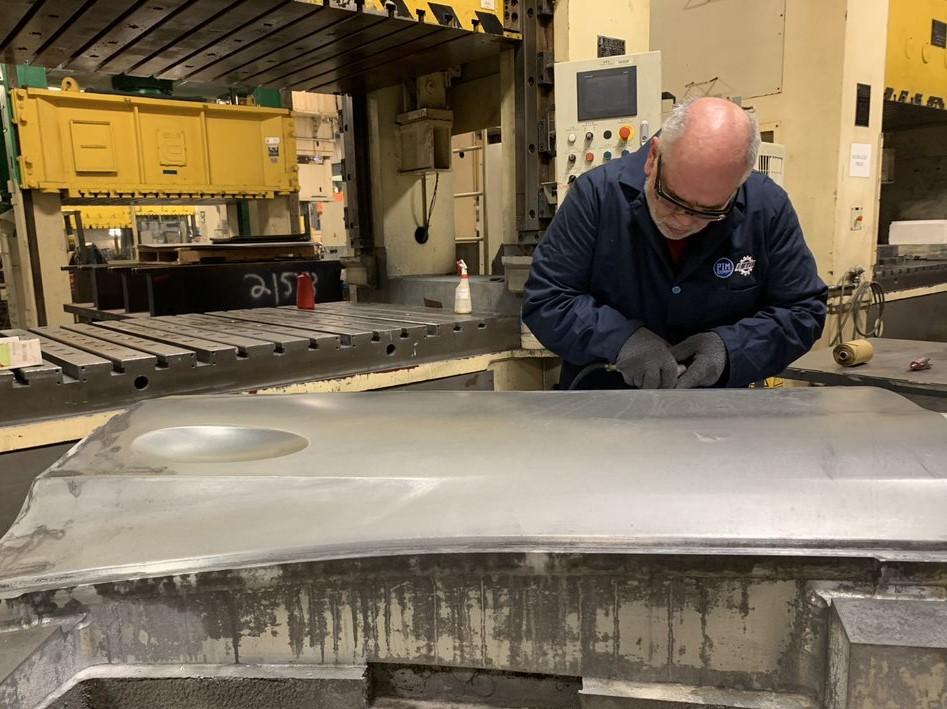Contributing editor
- FMA
- The Fabricator
- FABTECH
- Canadian Metalworking
Categories
- Additive Manufacturing
- Aluminum Welding
- Arc Welding
- Assembly and Joining
- Automation and Robotics
- Bending and Forming
- Consumables
- Cutting and Weld Prep
- Electric Vehicles
- En Español
- Finishing
- Hydroforming
- Laser Cutting
- Laser Welding
- Machining
- Manufacturing Software
- Materials Handling
- Metals/Materials
- Oxyfuel Cutting
- Plasma Cutting
- Power Tools
- Punching and Other Holemaking
- Roll Forming
- Safety
- Sawing
- Shearing
- Shop Management
- Testing and Measuring
- Tube and Pipe Fabrication
- Tube and Pipe Production
- Waterjet Cutting
Industry Directory
Webcasts
Podcasts
FAB 40
Advertise
Subscribe
Account Login
Search
Second-gen Michigan stamper proves out her mettle through prototyping
Perfecting the part, perfecting the process, reducing part cost in metalforming
- By Kate Bachman
- November 15, 2020
- Article
- Bending and Forming

A highly skilled fabricator qualifies a part to ensure that it meets customer specifications. The nature of prototyping is such that there are times when each part needs a craftsperson to fine-tune-shape it to specification by hand. Images provided by PTM Corp.
Most stamping manufacturers conduct some prototyping in their operations. Usually, it is offered as a service but not necessarily a revenue source. Rarely does prototyping comprise 50% of a stamping manufacturer’s business. Not only does prototyping sustain half PTM Corporation's business, it is so sizable that it comprises two prototyping divisions.
“Fifty percent of our revenue is based on prototyping, R&D, and helping our customers with their problems,” said PTM President/CEO Donna Russell-Kuhr.
“We try to become more involved on the engineering side of prototyping because, at that point, we can help make sure it’s manufacturable. That’s the biggest distinction between prototyping and production. When we design or help our customer design a prototype, we do it so it can meet mass production requirements,” Russell-Kuhr said.
That business strategy has helped the Fair Haven, Mich., stamper grow to a Tier 1 and 2 supplier, with multiple facilities occupying more than 300,000 square feet and nearly 300 employees. The stamping manufacturer recently invested $1.7 million in a plant expansion.
Objectives for Prototyping
There are many potential objectives for—and benefits of—prototyping.
Perfect the Part. One goal of prototyping is to prove out the part. PTM might stamp three or four versions of a part and before the customers buyoff depending on size and complexity, Russell-Kuhr said.
“While you’re creating prototypes, you learn a lot about that part. You learn about the metal, the properties, and the problems that you may have,” she said. “We work with customers at the prototype stages to understand the part’s purpose and function so we provide the customer a product that’s repeatable in production.”
“It’s costly to make engineering changes at the production stage,” added Director of Business Development, Estimating, and Engineering Steve Kuhr.
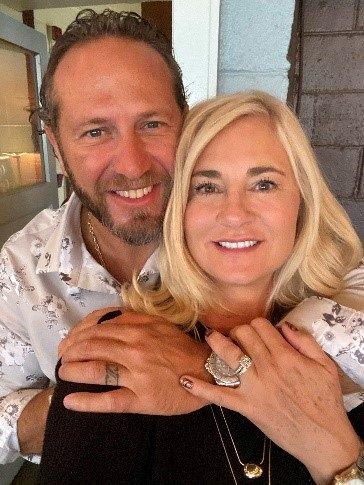
Donna Russell-Kuhr succeeded her father as PTM Corp. president and CEO in 2015. Since, she, her husband, Director Steve Kuhr, and her three sisters, who are co-owners, have grown the dynamic company. PTM recently added a $1.7 million facility expansion.
“When we receive CAD part data that is not ready for production manufacturing, that is where our team comes into play to help ensure that the final part is manufacturable and at a feasible price point,” Kuhr added.
One of the successful approaches PTM takes that may be unique is that when they make a prototype, it mirrors the final stamping processes closely.
“In prototyping, you can make anything. Everything in prototype is capable because you have time to shape it, to bend it, and you can use hand tools to put the part in specification. You can make things that would never be feasible to make in production,” Kuhr said.
Save Money. Another PTM goal for prototyping is to find ways to eke cost out of the part. “We work with the customer, and their engineering and quality teams to determine what is acceptable while meeting specifications and building quality into the product,” Kuhr said.
Russell-Kuhr offered an example. “A customer might want to prove out the same part in three different metal thicknesses to determine how thin the material can run and still meet design criteria. When you run 30 million production parts of a given part number, reducing your metal thickness saves a lot of money.”
Develop Costing Models. Another prototyping objective is to develop costing models. This is especially relevant as more electric vehicles move into the mainstream, Russell-Kuhr said. “So many electric vehicle companies are going to be launching in the next few years, and there’s no way on God’s green earth they’re all going to be winners. Most production volumes will be very low.”
PTM is working with an electric vehicle OEM in the prototype stage to help it gear its costing model for low-volume production stampings and assemblies at an initial low-volume rollout so that it is mutually profitable, Russell Kuhr said. “We’re working out where they can make money and we can make money. Because no one knows exactly how well and how soon these electric vehicles and hybrids are going to sell.”
Develop Cost-sensitive Prototype Tooling. It’s essential at the prototype stage to be able to design and build tooling to meet customer needs. At the same time, much is learned from the prototype tooling that can benefit the production tooling. Most cost avoidances can be made at this stage in prototype to develop lessons learned and carry over to production tooling and processes. The benefits of prototyping can outweigh high engineering costs of production tool changes.
“When a customer comes to us with a low-volume part, we can’t be competitive with production tooling costs. Our advantage is that we know production and prototype and how to design and produce robust prototype tools at a lower cost,” Kuhr said.
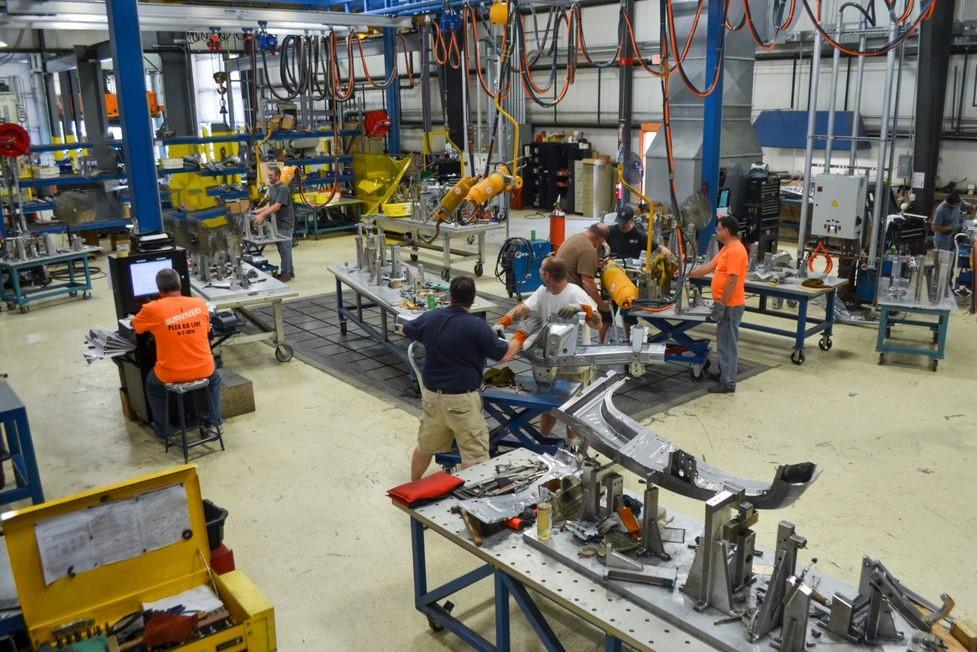
Prototyping is such a major part of PTM’s business—half—that the manufacturer has two prototyping divisions.
Quick Turnaround. Time constraints are an ever-present challenge for the prototype divisions. “With prototyping, you don’t have a lot of time,” Russell-Kuhr said. “Even in low volumes, making these parts is a slow process. It really comes down to tool design and how we manufacture and assemble the parts.”
The Prototyping Process, Step by Step
The company divides its prototyping division into large parts and assemblies and small components. The company created two divisions because there are a few differences in the way they handle large and small prototypes—and in how far their customers want to take them.
The first step is the RFQ process for both large and small prototypes. “We look at the part, and evaluate it through engineering. We put an estimate together of how many forming stations there should be for the part,” Kuhr said.
“If we get the program, we’ll design the blank based on the overall parameters of the part.”
From there the processes deviate, depending on whether they are large or small prototypes.
Large Prototypes. The job is run through Autoform simulation software. Based on that simulation, the engineers develop their first draw tool. There could be three- or four-piece tools. “Once that tool is completed, the engineering group provides a rough blank size, and we’ll cut that on the shear or on the laser,” Kuhr said.
The laser blanks are cut on PTM’s 8,000-Watt, 3-axis fiber laser cutting machine. “What’s nice about using a laser machine to blank is that when there are design changes, we don’t have to change a blank tool to blank the part out; we can just change a program,” Russell-Kuhr said.
Once the blank is laser-cut, it heads to the forming and drawing processes.
Kuhr outlined the process steps. “We perform part tryout and prove out the blank dimensions are correct, the cutoffs are fine, and we’re not wrinkling material during drawing. When we get close enough, we pull what’s now the stamped part out of the press, and that’s called a draw shell. We take the draw shell back to the laser department and trim the part.
“Then we take it back to the secondary form stations. We form the geometry characteristics into the part through a series of stamping stations.”
The largest press is 2,000-ton. “We’re forming fenders, doors, hoods, and Class A surfaces. We provide assemblies on closures as well as highly complex assemblies such as front-end and rear rails,” he said.
Normally it takes only two or three hits to form a door or fender, with a couple of laser trims in between. But each part is unique, and the number of stations varies for each prototype process. One operation had 28 forming stations after it was laser-blanked to become a finalized part.
On occasion prototype parts need hand qualifying, but simulation software mitigates that to a minimum.
Small Prototypes. The small-prototype process starts similarly to the large prototypes, with some significant differences.
“It’s similar to our large-prototype process in that we create a developed blank which is laser-cut. Then we use a series of line dies to form the part. But we mirror our stamping production process more closely throughout our small prototype process,” Kuhr said.
“Think of a progressive die, and each station is pulled out and set in a series of small presses to form the part to its specifications,” he explained. “We perform each of the operations in a number of small, single presses. This produces parts with characteristics similar to mass production.”
Small Parts. The design, engineering, and manufacture of small prototypes is quite different from large prototypes, Kuhr said. “Prototyping brackets, clips, and metal fasteners is totally different than how we make a fender or a door.
“Our small-prototype shop stamps parts so small that you can literally put 50 of them in the palm of your hand. We make jewelry over there!” Russell-Kuhr added.
In the design stage, engineers always look for ways to consolidate parts, Kuhr said. At the same time, the forming of the small parts is simplified. The small-parts forming is limited to bend radiuses and angles, mainly. “A small bracket might have a 90-degree bend in it, while a large prototype has all kinds of forms that you could never do with the small prototype process.”
Prototype to Production
Unsurprisingly, PTM welcomes running the prototype parts they developed in large-volume production runs. “We take on those low-volume jobs—a few hundred parts or more and before you know it, we’re quoting large-volume production. That’s kind of how we migrated prototyping into production and it made a natural fit for our business model growth,” Russell-Kuhr said.
About half of othe jobs for small-part prototype programs go into production tooling and production facilities; however, once the large prototypes are perfected, the OEMs usually perform the production. “We might prototype a door for an OEM, but their own production facility will run production and our work ends at the prototype stage. Automakers like to control their Class A process, especially outer skins,” Kuhr said.
Russell-Kuhr remarked, “We feel that our competitive advantage is we offer both prototyping and mass production, which provides our customers a better result for their mass production process.”
Finding a Way
Because so many unknowns accompany prototyping, inventiveness is required. “We always find a way,” Russell-Kuhr said. Finding a way is rooted in the family-owned company’s origins.
hat family legacy story began with Donna’s father, Charlie Russell, whose scrappy ingenuity transported him from a poor cotton-picking sharecropper in Mississippi to starting a small prototype shop in Michigan with one customer to help him start his new venture. Russell passed away in 2016; however, his legacy lives on as the shareholders and employees have continued to carry on that “can-do team spirit.”
“Dad started with nothing and applied his wits and ingenuity to solving problems the best, quickest, and least expensive way—and just helping his customers,” Russell-Kuhr said. “That was always at my dad’s heart. Somebody has a problem, and we’re going to find a solution for them. He would do whatever he needed to make them happy, and my mom would come in and help him.
“We have a code of honor at our company,” she continued. “It’s about how we want to conduct business with our customers, each other as employees, and our suppliers, no matter what the conditions are—if the economy isn’t doing well, or there’s a pandemic. Our number 1 code of honor is ’deliver exceptional performance and peace of mind to our customers.’
“We trust that our corporate values will carry on in our next generation of family and those new people who succeed us. We believe that this is what keeps our company together through the good times and the not-so-good times.”
About the Author

Kate Bachman
815-381-1302
Kate Bachman is a contributing editor for The FABRICATOR editor. Bachman has more than 20 years of experience as a writer and editor in the manufacturing and other industries.
Related Companies
subscribe now

The Fabricator is North America's leading magazine for the metal forming and fabricating industry. The magazine delivers the news, technical articles, and case histories that enable fabricators to do their jobs more efficiently. The Fabricator has served the industry since 1970.
start your free subscription- Stay connected from anywhere

Easily access valuable industry resources now with full access to the digital edition of The Fabricator.

Easily access valuable industry resources now with full access to the digital edition of The Welder.

Easily access valuable industry resources now with full access to the digital edition of The Tube and Pipe Journal.
- Podcasting
- Podcast:
- The Fabricator Podcast
- Published:
- 04/16/2024
- Running Time:
- 63:29
In this episode of The Fabricator Podcast, Caleb Chamberlain, co-founder and CEO of OSH Cut, discusses his company’s...
- Trending Articles
Tips for creating sheet metal tubes with perforations

Are two heads better than one in fiber laser cutting?

Supporting the metal fabricating industry through FMA

JM Steel triples capacity for solar energy projects at Pennsylvania facility

Omco Solar opens second Alabama manufacturing facility

- Industry Events
16th Annual Safety Conference
- April 30 - May 1, 2024
- Elgin,
Pipe and Tube Conference
- May 21 - 22, 2024
- Omaha, NE
World-Class Roll Forming Workshop
- June 5 - 6, 2024
- Louisville, KY
Advanced Laser Application Workshop
- June 25 - 27, 2024
- Novi, MI
























